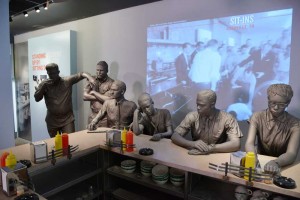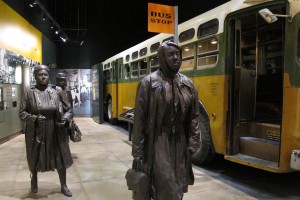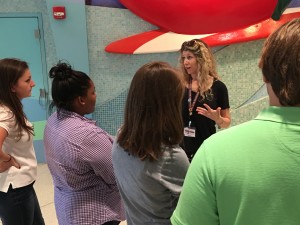Amplify Memphis Day Six: A Powerful Experience in the Dichotomous Nature of Our History
Today’s blog post authors are Cecelia Cordera (’17) and Maggie Kay Imorde (’20):
Growing up in Memphis, Tennessee meant that the Civil Rights Movement has always been a piece of history close to my heart being that many incredibly historic events in this movement took place in my home town. I had first visited the National Civil Rights Museum many years ago but because I took U.S. History this year, this piece of history was fresh in my mind. Touring this museum was an incredibly powerful experience. It accurately captures the events that occurred during this remarkable movement and gives the individual a direct look into the events that really occurred.
The museum is separated into chronological order beginning with the start of slavery in America and ending with the assassination of Dr. Martin Luther King Jr. on the balcony of the Lorraine Motel right here in Memphis. We each picked eight exhibits out of the twenty  four on permanent display and studied these specifically to get a more precise view into a handful of events rather than be overwhelmed by all that was presented. The first exhibit I picked was entitled “I, Too, Am America: Combatting Jim Crow 1896-1954”. The Jim Crow Laws were basically the backbone of white racism, the foundation whites stood on in order to justify their inhumane treatment of an entire people. The South, and our home town of Memphis, was a breeding ground for extreme racism. While slavery was outlawed by the time of the Civil Rights Movement, the superiority ideology of whites believing they are better than blacks remained. Therefore, Jim Crow Laws thrived. Jim Crow Laws were incredibly complicated and included many restrictions including blacks rights to vote, their seating arrangement on bus systems, and their ability to go to certain public places such as parks and restaurants. Jim Crow Laws were the reason blacks had to fight back and embark on their quest for freedom and equality.
four on permanent display and studied these specifically to get a more precise view into a handful of events rather than be overwhelmed by all that was presented. The first exhibit I picked was entitled “I, Too, Am America: Combatting Jim Crow 1896-1954”. The Jim Crow Laws were basically the backbone of white racism, the foundation whites stood on in order to justify their inhumane treatment of an entire people. The South, and our home town of Memphis, was a breeding ground for extreme racism. While slavery was outlawed by the time of the Civil Rights Movement, the superiority ideology of whites believing they are better than blacks remained. Therefore, Jim Crow Laws thrived. Jim Crow Laws were incredibly complicated and included many restrictions including blacks rights to vote, their seating arrangement on bus systems, and their ability to go to certain public places such as parks and restaurants. Jim Crow Laws were the reason blacks had to fight back and embark on their quest for freedom and equality.
Once the Civil Rights Movement began, many different campaigns and protests began in order to combat the laws in place during the fifties and sixties. I looked at Brown vs. Board of Education, which was the Supreme Court case tha t ended segregation based on race in schools, the Montgomery Bus Boycott which began with Rosa Park’s refusal to give up her seat for a white man, and “sit-ins.” The sit in movement really stood out to me because it was one of the first national movements of the 1960’s Civil Rights Campaign and a woman named Clara Luper was instrumental in this campaign. I found her incredibly interesting, first and foremost because she was a woman, and that she was also a teacher who was leading this incredibly effective and dangerous campaign. However, once she began to lead the sit ins, her teaching license was revoked and she was arrested over a dozen times. I loved the fact that the CivilRights Movement was lead by both men and women. Women lead campaigns, protests, and movements that were vital to the cause and helped shaped the course of history. Women were equally as important as men and the Civil Rights Movement never would have taken place without women such as Rosa Parks and Clara Luper.
t ended segregation based on race in schools, the Montgomery Bus Boycott which began with Rosa Park’s refusal to give up her seat for a white man, and “sit-ins.” The sit in movement really stood out to me because it was one of the first national movements of the 1960’s Civil Rights Campaign and a woman named Clara Luper was instrumental in this campaign. I found her incredibly interesting, first and foremost because she was a woman, and that she was also a teacher who was leading this incredibly effective and dangerous campaign. However, once she began to lead the sit ins, her teaching license was revoked and she was arrested over a dozen times. I loved the fact that the CivilRights Movement was lead by both men and women. Women lead campaigns, protests, and movements that were vital to the cause and helped shaped the course of history. Women were equally as important as men and the Civil Rights Movement never would have taken place without women such as Rosa Parks and Clara Luper.
Next I looked at the Selma Voting Rights Campaign, the Black Power Movement, Black Pride, and lastly, the sanitation strike that was the cause of Dr. King’s life coming to Memphis where he met his end. Each of these topics were incredibly moving and powerful, all representing the immense struggle the African American community had to endure in order to gain their inalienable rights. Their power and endurance is unparalleled to any movement I have ever read about or studied in history classes. While I am incredibly proud to be a born and raised Memphian, it hurts my heart to know about all of the evil that took place here against an entire community. Dr. King’s mission was both powerful and inspiring. I think that we can all learn from what occurred in the past, prevent it from happening again, and emulate the actions of Dr. King. I thoroughly enjoyed our visit to the Civil Rights museum and learned a lot about the historical events that occurred in our city.
As part of today’s journey, we also visited St. Jude Children’s Research Hospital. The majority of us had never been to St. Jude before so we were all very excited to explore this hospital known all over the world for the way that it helps children and families, turning no one away from care. We split up into two groups because only people sixteen and older were able to go on the tour inside the actual hospital where patients were being treated. The group that was under sixteen stayed in the pavilion. In the pavilion, there were a few exhibits that showed different aspects of St. Jude. A few of the exhibits were about the founder, Danny Thomas, as well as the  mission of the hospital and how the hospital raises support. The younger group was given the chance to walk around the pavilion and look at those exhibits while the older group was touring. They were also able to visit the garden at St. Jude. The garden was a calm environment with shady trees, flowers, and a couple of fountains, and it was overall very peaceful. The older group saw where patients were treated for various ailments, special facilities for family members and friends of the hospital to give blood directly to those being cared for, and where research was being done at the hospital. There were a couple of facts that I thought were very interesting. One of them was how St. Jude has teachers who help the patients stay on track for school and not get behind. The teachers even communicate with the patients’ teachers at schools so that they are teaching the correct things. Also, I never knew that St. Jude pays for all the costs of the treatments not covered by insurance, which I found amazing. We sat together at the end of the day and we talked about not only what we had learned about St. Jude, but also our thoughts about our experiences at the National Civil Rights Museum. It was a very powerful day.
mission of the hospital and how the hospital raises support. The younger group was given the chance to walk around the pavilion and look at those exhibits while the older group was touring. They were also able to visit the garden at St. Jude. The garden was a calm environment with shady trees, flowers, and a couple of fountains, and it was overall very peaceful. The older group saw where patients were treated for various ailments, special facilities for family members and friends of the hospital to give blood directly to those being cared for, and where research was being done at the hospital. There were a couple of facts that I thought were very interesting. One of them was how St. Jude has teachers who help the patients stay on track for school and not get behind. The teachers even communicate with the patients’ teachers at schools so that they are teaching the correct things. Also, I never knew that St. Jude pays for all the costs of the treatments not covered by insurance, which I found amazing. We sat together at the end of the day and we talked about not only what we had learned about St. Jude, but also our thoughts about our experiences at the National Civil Rights Museum. It was a very powerful day.